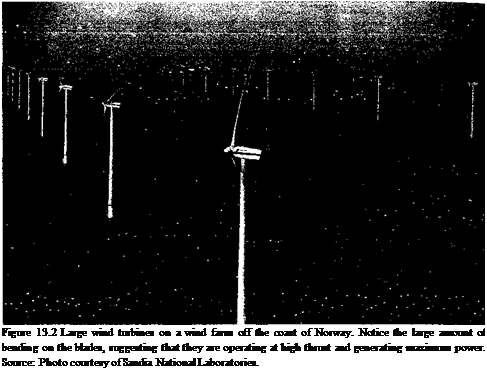History of Wind Thrbine Development
The power of the wind has been used by humankind for millennia (e. g., sailing ships). Wind turbines are more recent machines, but the basic concept dates back many centuries with primitive forms being used in Babylonian times – see Shepherd (1990). More advanced wind turbines were used by the Persians in the seventh century and had become more widespread in Europe by the fifteenth century. The most common machine was the tower mill, which was used for grinding and milling grain. These windmill machines underwent systematic improvements by trial and error and, by the seventeenth century, had evolved into a surprisingly high level of sophistication, to the point of using twisted blades with tapered planforms and control devices to point the windmill into the wind automatically. This suggests a good empirical knowledge of aerodynamics that was well in advance of the contemporary scientific understanding. Dutch settlers brought the windmill to the Americas in the eighteenth century. Another common windmill variant, the American fan mill, saw widespread use throughout the nineteenth and twentieth century for pumping water on ranches. By the beginning of the twentieth century, wind turbines were being used commercially to generate electrical power, although on a relatively small scale. The last century has seen considerable development in wind turbine technology, especially in Europe where energy costs are relatively high compared to the United States. The oil crisis during
|
Figure 13.1 A modem three-bladed wind turbine. Source: Photo courtesy of Sandia National Laboratories. |
the 1970s saw some new efforts to develop renewable energy resources in the United States, including wind energy. Today wind turbines are playing an increasing role in the generation of electrical power worldwide; concerns about global warming and the storage of waste from nuclear power plants have placed an increased emphasis on wind energy. As of 2005, the estimated global capacity for the creation of electrical power from wind energy was in excess of 25 GW, representing about 2% of total energy demands; see Thresher (2002).
An example of a modem horizontal axis wind turbine (HAWT) is shown in Fig. 13.1. Wind turbines are distinguished according to the orientation of the rotor shaft axis; in this case the shaft is parallel to the ground. This is the most common type of wind turbine and is also often referred to as a “lift machine” (as opposed to a “drag machine”) because the power output comes from the generation of lift forces on the rotating blades. The HAWT sits on a tall tower, which may be either upstream or downstream of the turbine. In the downwind type the turbine axis naturally tries to align itself parallel to the wind, but these turbines do not always track the wind accurately. The tower also produces a wake (a tower “shadow”) in this configuration and this affects the aerodynamic AoA and airloads on the turbine blades, making them unsteady. The vertical axis wind turbine (VAWT) or Darrieus turbine [Darrieus (1931)] has seen less extensive use, although this machine has the advantage that it will generate power with the wind from any direction and a means of controlling yaw is not required. Another type of VAWT is the Savonius turbine [see Savonius (1931)], which is a drag machine. However, VAWTs tend to be less efficient compared to HAWTs but, more importantly, they are not easily scaled up to the large size required for commercial power production because of structural design difficulties and aeroelastic problems.
A modem commercial wind turbine (see Fig. 13.1) may range from as little as 5 m (16.4 ft) in diameter up to over 100 m (328 ft) in diameter. Small turbines produce power in
 |
the range from a few kilowatts, with the larger ones being in the megawatts capacity. Modem utility-scale wind turbines all have diameters greater than 50 m (164 ft). Many wind turbines are often seen together in a group known as a wind farm (see Fig. 13.2). Even in farms, however, the net cost of energy generated by wind turbines has historically been greater than that for power produced from fossil or nuclear fuels. Their unique aerodynamic and mechanical problems and overall difficulties in predicting the performance and structural loads on wind turbines has led to high capital investment, as well as to high operating and maintenance costs. Until recently, this has made it difficult for wind energy devices to compete with other forms of renewable and nonrenewable energy sources – see Hansen (1993). Today the costs of fossil fuels are increasing and wind energy costs are decreasing. The ever-increasing global emphasis on environmental issues also favors the use of wind turbines compared to more traditional forms of power generation.












